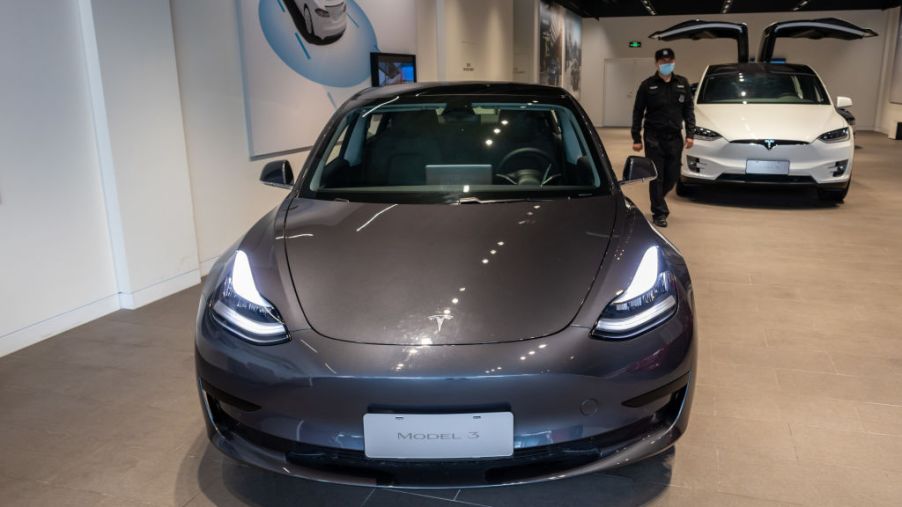
Tesla Autopilot Technology Killed a Man in Japan, According to This Lawsuit
Napping behind the wheel? Nope. Even with a “self-driving” car, the driver has to be awake and aware. Self-driving cars are right over the horizon, with Tesla leading the way. There have been some serious bumps in the road along the way, most notably a pedestrian fatality when the Model X driver fell asleep at the wheel.
The first Tesla Autopilot pedestrian fatality
Elon Musk, the mind behind the electric car brand Tesla, is working hard to engineer a self-driving car – one that cruises along on autopilot while the driver theoretically sits back and enjoys the ride. But the reality of the self-driving car is still confined to test drives and Disneyland, as one lawsuit that derived from a tragic accident in Japan highlighted recently, per Car Complaints.
A Tesla Model X hit a motorcyclist in Kanagawa, Japan, in April of 2018. The lawsuit alleges that several of the autopilot sensors in the car failed, and the driver was unaware of the failures as he had apparently dozed off prior to the accident. The victim was standing in a group of parked cyclists when the Tesla plowed into the group, fatally injuring that individual.
How did this happen?
According to the court filings, the Tesla failed to sense when the car in front of it signaled a lane change and then slowed down to avoid hitting the pedestrians in front of it. The Tesla had been traveling at about 9 MPH but accelerated to 24 MPH when the car in front moved over, hitting the crowd of cyclists.
The driver of the Tesla had his hands on the steering wheel (verified by Tesla’s Autosteer technology) but did nothing to stop, slow, or move the car. What’s interesting is that the lawsuit does not charge the driver with anything, but rather Tesla for building a defective car.
There were multiple failures in the autopilot systems. The cameras did not sense the vehicle in front slowing down or changing lanes, and the emergency braking system failed to notice the parked motorcycles in front as the car accelerated.
The NTSB has ruled that Tesla’s technology is insufficient for total driver disengagement, and that monitoring the driver’s interaction with the steering wheel is a poor indicator of engagement. The lawsuit, filed in Tesla’s home state of California, alleges that Tesla willfully ignored the NTSB’s recommendations for safety regulators, and is seeking damages on behalf of the victim’s family.
Other Tesla fatalities have involved the driver; this was the first one where a pedestrian was the victim. Tesla has always maintained that the driver is ultimately responsible for driving the vehicle and that the autopilot function is simply an enhancement.
Will self-driving cars really happen?
If you’re thinking that self-driving cars are some futuristic fantasy, think about all the features of your new car that were unheard of 20 years ago. Cruise control was just the beginning of automated driving; now your car lets you know when you’re following too closely, when the car ahead of you slows down, and when it’s safe to change lanes.
So you’re practically piloting an autonomous vehicle (AV) now, but you’re still in control and wouldn’t dream of napping or watching a movie while you’re behind the wheel.
AVs are safer
AVs will happen, and the roads will be safer when they do. One of the biggest advantages of a self-driving car is that it knows the rules of the road, follows the speed limit and isn’t tempted to text and drive. Transitioning from current technologies to AVs will be the hard part, but once all the cars on the road are smarter than you, those roads are going to be a lot less dangerous.
According to the USDOT, over 94 percent of crashes are caused by human error. The endgame for AVs is to not only reduce traffic fatalities but also to reduce the number of cars on the roads. AVs will not necessarily be private vehicles, but part of the on-demand rideshare economy.
Good news for Tesla
The Japanese lawsuit isn’t going away, but there is some good news for Tesla’s autopilot software. The owner of a 2018 Tesla Model 3 AWD drove his car on autopilot on the Blue Ridge Parkway in North Carolina for over an hour in foggy weather on a spiral mountain road. This drive included tunnels and a bridge hanging over the side of the mountain, and the autopilot function handled both with ease.


